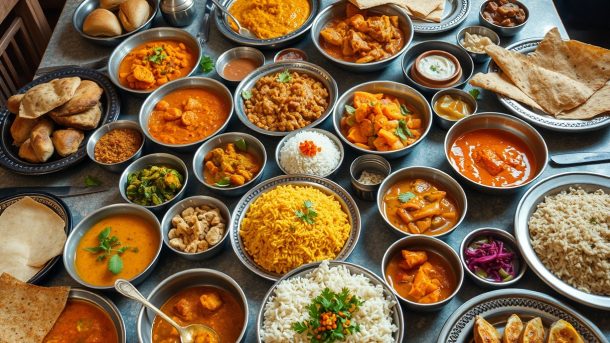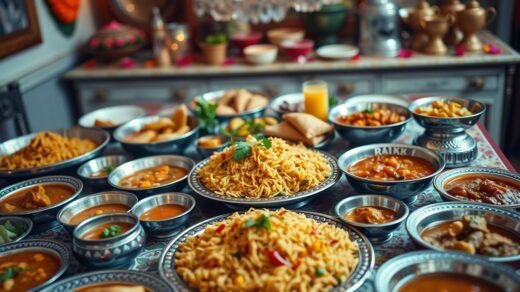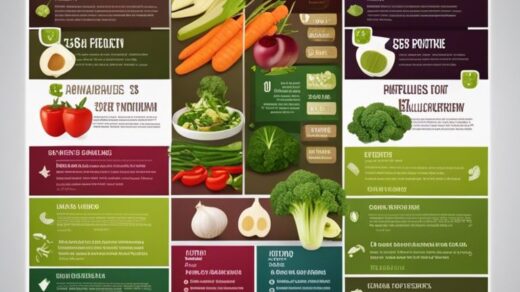Variety #Cuisine encompasses the rich tapestry of culinary traditions found across India. When you explore Indian food, you commence on a journey through diverse regional flavors, ingredients, and cooking techniques that reflect the country’s cultural heritage. From the spicy curries of the south to the sweet delicacies of the north, each region boasts its unique dishes and culinary practices. In this blog post, you will gain a deeper understanding of the various types of food that make India a true gastronomic paradise.
Key Takeaways:
- Diversity: India boasts an immense variety of cuisines due to its diverse cultures, religions, and geographical regions.
- Regional Specialties: Each state and region has its own unique dishes and ingredients, resulting in hundreds of different food types across the country.
- Vegetarianism: A significant portion of Indian cuisine is vegetarian, influenced by cultural traditions and religious practices, adding to the variety of food types available.
Regional Cuisines
While India is home to a diverse array of culinary traditions, regional cuisines play an integral role in shaping its gastronomic landscape. Each region boasts unique flavors, cooking techniques, and local ingredients, creating a tapestry of tastes that truly represents the country’s rich heritage. To explore the vibrant world of Indian food, you can read more in this article on India Food: 25 Most Popular Traditional Dishes To Eat In ….
Northern India
With its delectable offerings, Northern India is renowned for its hearty dishes that often feature rich gravies, aromatic spices, and a variety of bread such as naan and roti. Staples include dishes like butter chicken, paneer tikka, and biryani, often enjoyed with a side of pickles and yogurt.
Southern India
On the other hand, Southern India delights with its light, spicy, and tangy flavors, showcasing the use of rice, lentils, and coconut as primary ingredients. Dishes like dosa, idli, and sambar reflect the region’s culinary vibrancy.
It is imperative to note that Southern Indian cuisine varies widely between states, with each offering distinct preparations. For example, while Karnataka is known for its Mysore masala dosa, Kerala specializes in seafood dishes infused with coconut milk and spices. Whether you are indulging in a hearty thali or a simple bowl of rasam, Southern Indian food emphasizes natural flavors and freshness.
Eastern India
India’s Eastern cuisine is known for its use of mustard oil and flavors that are more subtle yet equally delicious. Signature dishes like fish curry, rice, and a variety of sweets such as rasgulla and sandesh highlight the richness of this region’s culinary traditions.
Another aspect of Eastern Indian cuisine is its celebration of fresh ingredients and unique cooking methods. The region takes pride in its seafood, especially in West Bengal where fish has a central role, often cooked with aromatic spices and served alongside steamed rice. This region also has a notable dessert culture, with sweets being an integral part of its culinary identity.
Western India
India’s Western cuisine is characterized by a variety of spices and regional specialties that reflect its diverse geography. Dishes like dhokla, bhindi masala, and vindaloo represent the unique flavors from this part of the country.
The Western region encompasses diverse states like Gujarat, Maharashtra, and Rajasthan, each contributing distinct culinary delights. For instance, Gujarat favors vegetarian dishes featuring lentils and beans, while Maharashtra is famous for its seafood and street food culture, such as vada pav and pav bhaji. Rajasthan, on the other hand, offers robust flavors in its meat dishes, often paired with traditional breads. Together, these states create a rich culinary landscape that captivates the taste buds.
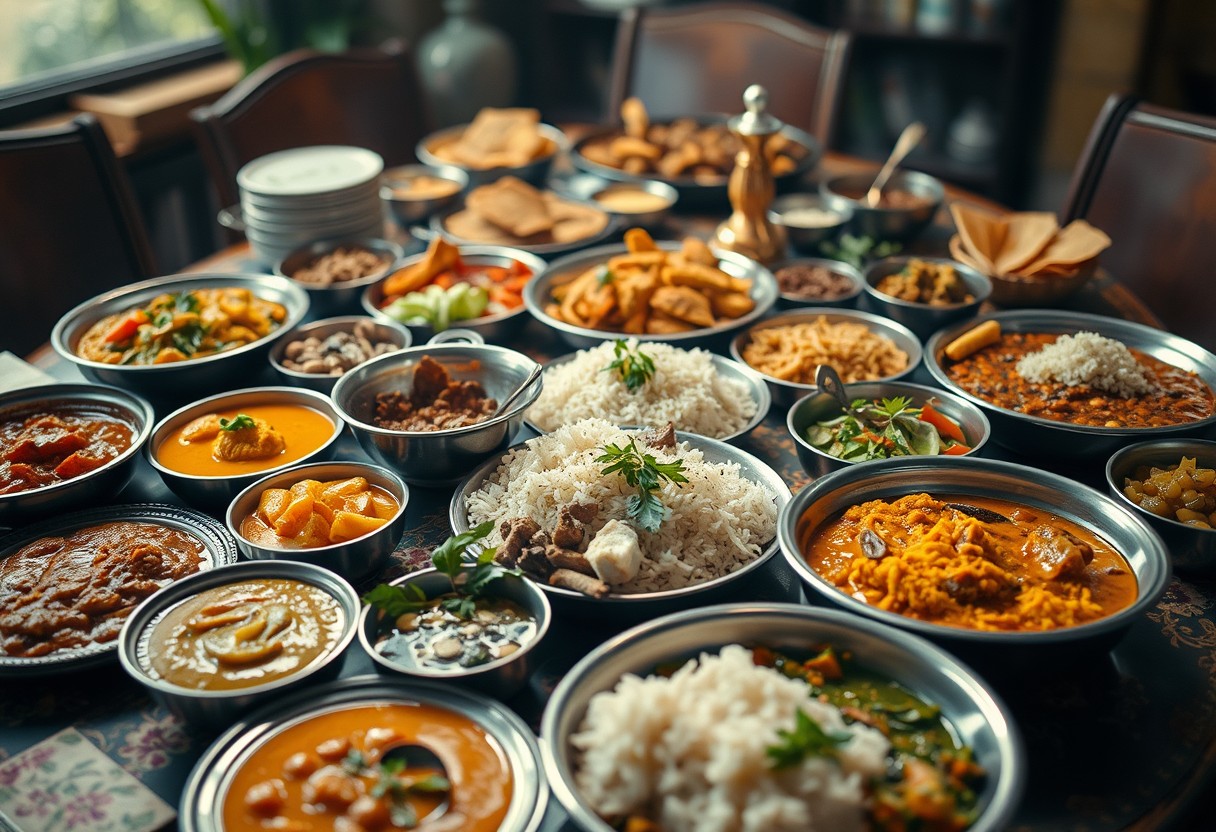
Staple Foods
You will find that staple foods in India are diverse and play a crucial role in the daily diets of its people. These staples primarily consist of grains, pulses, and vegetables, each contributing significantly to the nutritional needs of various regions across the country.
Grains
Grains form the foundation of Indian cuisine, with rice and wheat being the most commonly consumed staples. In southern states, rice dominates the diet, while in the northern regions, wheat is more prevalent, often consumed in the form of bread such as roti or naan.
Pulses
On the other hand, pulses are necessary in Indian cooking, providing a crucial source of protein. They come in various forms, including lentils, chickpeas, and kidney beans, and are often combined with spices to create flavor-rich dishes that complement staple grains.
This emphasis on pulses contributes to not only a balanced diet but also the richness of Indian culinary traditions. You’ll find them featured in dishes like dal, which is a staple across numerous Indian states, showcasing the versatility and importance of these legumes in your daily meals.
Vegetables
Any Indian meal typically includes a variety of vegetables, which enhance both flavor and nutrition. Regional variations dictate the types of vegetables used, with seasonal availability influencing common choices in different areas.
Understanding the role of vegetables in Indian cuisine is necessary, as they not only provide necessary vitamins and minerals but also contribute to vibrant flavors and textures. From spicy curries to fresh salads, vegetables are an integral part of your dietary intake, making Indian cuisine both colorful and nutritious.
Influential Dietary Practices
Keep in mind that India’s culinary landscape is profoundly shaped by various dietary practices, reflecting the country’s diverse culture and beliefs.
Vegetarianism
For many Indians, particularly in communities influenced by religion, vegetarianism is a way of life, driven by spiritual, ethical, and health considerations. You’ll often find that a significant portion of Indian cuisine is vegetarian, with an impressive array of dishes that celebrate plant-based ingredients.
Ayurveda
Dietary practices in India are largely influenced by Ayurveda, the ancient system of medicine that emphasizes balance in one’s diet and lifestyle. With its focus on using natural foods to promote health and well-being, Ayurveda categorizes foods based on their qualities and how they affect the body. This holistic approach considers your unique constitution and aims to enhance overall vitality through mindful eating.
Street Food Culture
Food in India is incomplete without mentioning the vibrant street food culture that thrives in every corner of the country. You’ll discover that street food varies widely by region, offering delightful and often budget-friendly options that reflect local flavors and ingredients.
Vegetarianism plays a crucial role in the street food scene as you traverse bustling markets and roadside stalls. From crispy samosas to refreshing pani puri, the offerings are often entirely vegetarian, catering to the preferences of many. Street food not only serves as a delicious quick bite but also becomes an integral part of your experience as you explore India’s rich culinary heritage.
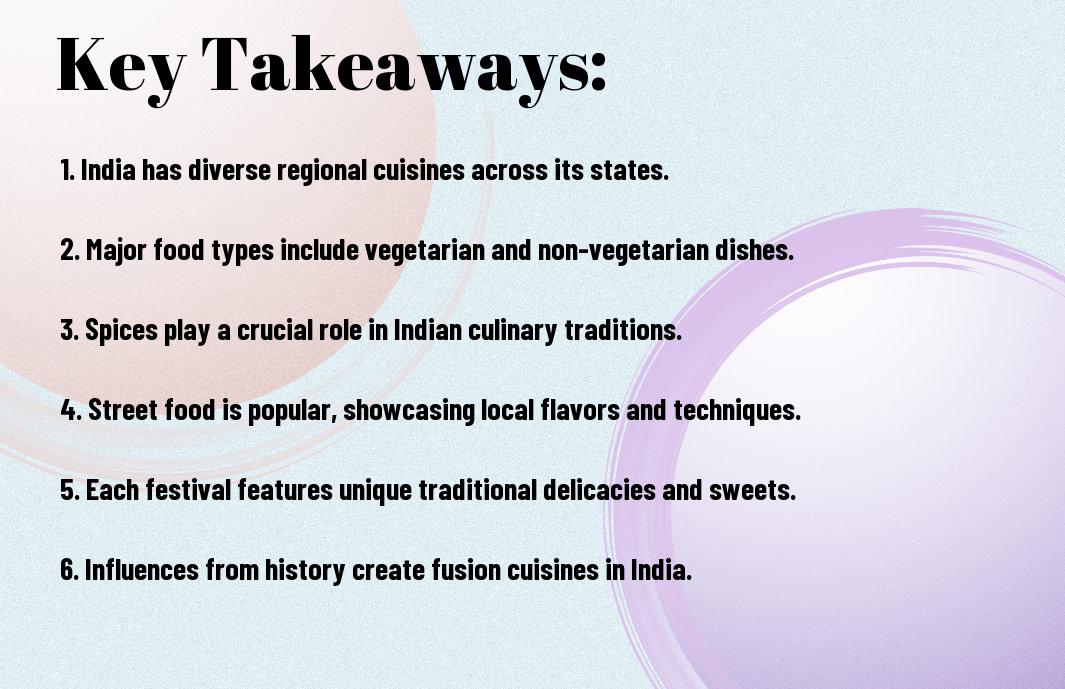
Conclusion
As a reminder, the vast diversity of food in India encompasses a plethora of regional flavors, cooking techniques, and ingredients, resulting in thousands of distinct dishes. From the spicy curries of the south to the rich biryanis of the north and the delectable street food found in bustling cities, you can explore an endless variety of culinary experiences. Understanding the different types of food available will not only enrich your palate but also deepen your appreciation for India’s rich cultural heritage.
FAQ
Q: How many types of food are there in India?
A: India is known for its diverse culinary landscape, which can be broadly categorized into several regional cuisines. Each region boasts its own unique ingredients, cooking techniques, and traditional dishes. Major types of food in India include North Indian, South Indian, East Indian, West Indian, and Northeast Indian cuisines, along with specialty foods such as street food, and sweets. Overall, there are thousands of distinct dishes across these various classifications, making Indian cuisine one of the most varied in the world.
Q: What are the main regional cuisines of India?
A: The main regional cuisines of India are:
1. North Indian Cuisine – Known for its rich gravies, naan, and tandoori dishes.
2. South Indian Cuisine – Famous for its rice-based dishes, dosas, and idlis.
3. East Indian Cuisine – Characterized by its use of fish, rice, and sweets like rasgulla.
4. West Indian Cuisine – Includes spicy foods like dal baati churma and dhoklas.
5. Northeast Indian Cuisine – Features ingredients like bamboo shoots, fish, and a variety of herbs and spices unique to the region.
Q: What are some common ingredients used in Indian cooking?
A: Common ingredients in Indian cooking include rice, lentils, various spices (such as cumin, coriander, turmeric, and garam masala), vegetables, yogurt, and dairy products. Each region may also incorporate local ingredients, resulting in a rich variety of flavors. For instance, coconut is prevalent in South Indian dishes, while mustard oil is commonly used in Eastern cuisine.
Q: Are there vegetarian and non-vegetarian options in Indian cuisine?
A: Yes, Indian cuisine offers a wide range of vegetarian and non-vegetarian options. In fact, a significant portion of the Indian population is vegetarian due to cultural and religious reasons. As a result, most Indian restaurants and households provide a variety of vegetarian dishes like paneer, sabzi, and dal, alongside non-vegetarian options including chicken, mutton, fish, and seafood dishes. Popular vegetarian styles include Jain and Vegan, which cater to specific dietary needs.
Q: How does the climate influence the food types in India?
A: The diverse climate across India, ranging from the snowy Himalayas to the tropical beaches of the south, greatly influences the local cuisine. Regions with a hotter climate tend to use more spices and herbs that have preservative properties, while cooler regions might focus on hearty, warming dishes. Additionally, coastal regions typically feature seafood prominently, while inland areas rely more on grains and legumes. Seasonal availability of ingredients also plays a significant role in determining the types of food that are prepared in various parts of the country.
